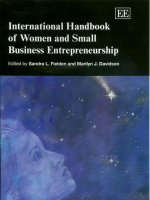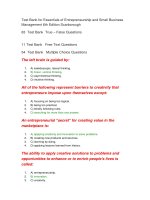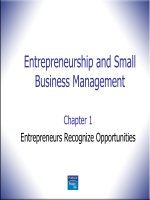innovation and small business
Bạn đang xem bản rút gọn của tài liệu. Xem và tải ngay bản đầy đủ của tài liệu tại đây (4.98 MB, 170 trang )
Download free eBooks at bookboon.com
2
Brychan Thomas, Christopher Miller and Lyndon Murphy
Innovation and Small Business
Volume I
Download free eBooks at bookboon.com
3
Innovation and Small Business: Volume I
© 2011 Brychan Thomas, Christopher Miller and Lyndon Murphy &
Ventus Publishing ApS
ISBN 978-87-7681-729-9
Download free eBooks at bookboon.com
Click on the ad to read more
Innovation and Small Business: Volume I
4
Contents
Contents
Foreword 6
Preface 7
Acknowledgements 9
1. Introduction 10
2. Invention, Innovation and Small Business 17
3. Research and Development and the Small Firm 27
4. Technology Diffusion 44
5. Clusters and Knowledge Flows 59
6. Higher Education Spin-offs 71
7. Global Start-ups and business development 89
8. Innovation Performance Indicators 106
Real individuality.
Unreal togetherness.
Meet one of our people and they’ll ask about you.
Not your resume. Because it’s you, the person, we’re
interested in. After all, it’s a big, diverse world out
there. Tackling global business challenges takes
different viewpoints and fresh thinking. Listening.
Sharing. Debating. It’s all part of the job. All we’re
missing is you. Visit ey.com/internships.
See More | Opportunities
© 2012 Ernst & Young LLP. All Rights Reserved.
Download free eBooks at bookboon.com
Click on the ad to read more
Innovation and Small Business: Volume I
5
Contents
9. Conclusions 127
References 131
Chapter 1: Introduction 131
Chapter 2: Invention, Innovation and Small Business 132
Chapter 3: Research and Development and the Small Firm 135
Chapter 4: Technology Diffusion 142
Chapter 5: Clusters and Knowledge Flows 144
Chapter 6: Higher Education Spin-offs 148
Chapter 7: Global Start-ups and business development 155
Chapter 8: Innovation Performance Indicators 160
Chapter 9: Conclusions 164
About the Contributors 165
Index 167
© Agilent Technologies, Inc. 2012 u.s. 1-800-829-4444 canada: 1-877-894-4414
Teach with the Best.
Learn with the Best.
Agilent offers a wide variety of
affordable, industry-leading
electronic test equipment as well
as knowledge-rich, on-line resources
—for professors and students.
We have 100’s of comprehensive
web-based teaching tools,
lab experiments, application
notes, brochures, DVDs/
CDs, posters, and more.
See what Agilent can do for you.
www.agilent.com/find/EDUstudents
www.agilent.com/find/EDUeducators
Download free eBooks at bookboon.com
Innovation and Small Business: Volume I
6
Foreword?
Foreword
With a modern society that is seeing fast changing social, economic, political and cultural developments
never before has innovation been more important for small businesses. As a consequence the study of
innovation is a fast developing area with publication of a number of leading texts. These however tend to
investigate innovation management activities in large businesses with limited consideration of the small
business area. This is disproportional to the amount of research activity that is being undertaken in the
small business field. These seminal texts into innovation management in large organizations have
previously considered popular, as well as requisite, concepts such as disruptive technology and more
recently open innovation and the “fuzzy front end”. Moreover, innovation is seen in terms of creativity
and the generation of new ideas. It is evident that whereas large companies are good at implementing
innovation, small companies are better at generating new ideas although research tells us that only around
10% will be commercially viable. Contributing to this innovation activity there will also be different
forms of innovation including product, process and service innovations and also radical and incremental
innovations.
In response to this gap this volume considers innovation and small business with particular reference to
the innovation process. Here an approach appropriate to small businesses is taken by considering the
distinction between invention and innovation as well as research and development in the context of the
small firms. In addition, technology diffusion, clusters and knowledge flows, higher education spin-offs,
global start-ups and innovation performance indicators are also considered with particular reference to the
small business sector.
The second volume considers industrial settings and essentially attempts to apply the theory considered in
volume one. Furthermore, this volume recognizes the contributions of small firms to these industries,
firmly establishing the pivotal role they play in future economic development and prosperity. This is
achieved by investigating a number of industries such as agri-food, health, energy, construction and
heritage. In particular there is consideration of innovative and sustainable solutions, the assessment of
research and development, technology and multimedia knowledge management systems.
Whilst it is recommended to read volume one before progressing to volume two, each volume has been
constructed so that they can be read independently of one another. Given this exciting and new approach it
is a pleasure to commend this text not only to students, researchers and scholars of small business but also
to policy makers, small business practitioners and owner managers.
Gary Packham
Professor of Entrepreneurship
Centre for Enterprise
University of Glamorgan
Download free eBooks at bookboon.com
Innovation and Small Business: Volume I
7
Preface
Preface
In modern technological society small businesses are expected to have an innovative role in the emerging
knowledge economy, especially at an international level (EC, 2005; BERR, 2008). In fact the effective use
of technological innovation is considered to be a prerequisite for small business survival (Packham, 2002;
Packham et al, 2005). It has long been recognised that the small business sector is important for economic
growth and it has been noted that there is a need for an international focus on small businesses having
access to international markets (OECD, 2005). Within this context it has been acknowledged that small
business development programmes and assistance should enable them to take advantage of innovative
global technologies (OECD, 2005). Although significant opportunities are presented to small businesses
through the adoption of new technologies there needs to be awareness to the barriers of implementation
and this has led researchers to focus on adoption factors (Parasuraman, 2000). Indeed, there has been little
success linking the determinants of adoption in small businesses with expected outcomes such as
innovation, apart from specialised research and development (R&D) intense sectors (Thomas and
Simmons, 2010).
Small businesses with an above average absorptive capacity tend to exhibit experience, knowledge, a
skills base, knowledge creation and sharing processes (Cohen and Levinthal, 1990; Zahra and George,
2002; Gray, 2006). Their effective use of networking and an optimal use of technological innovation are
the focus of this first volume. It is therefore hoped that this volume will provide a greater understanding of
these innovation processes for small businesses.
References
Cohen, W. and Levinthal, D. (1990) Absorptive Capacity: A New Perspective on Learning and Innovation,
Administrative Science Quarterly, 35(1), 128-152.
Department for Business, Enterprise and Regulatory Reform (BERR) (2008) Business Plan 2008–2011,
June, London.
European Commission (EC) (2005) Implementing the Community Lisbon Programme – Modern SME
Policy for Growth and Employment (COM) (2005), 551 final, November, Brussels.
Gray C. (2006) Absorptive capacity, knowledge management and innovation in entrepreneurial small
firms, International Journal of Entrepreneurial Behaviour & Research, 12(6), 345-360.
OECD. (2005) Small to Medium-Sized Business (SME) and Entrepreneurship Outlook, OECD, Paris.
Packham, G., Brooksbank, D., Miller, C. and Thomas, B. (2005) Climbing the Mountain: Management
Practice Adoption in Growth Oriented Firms in Wales, Small Business and Enterprise Development, 12,
482-497.
Packham, G. (2002) Competitive Advantage and Growth: The Challenge For Small Firms, International
Journal of Management and Decision-Making, 3, 165-179.
Download free eBooks at bookboon.com
Innovation and Small Business: Volume I
8
Preface
Parasuraman, A. (2000) Technology Readiness Index (TRI): a multiple-item scale to measure readiness to
embrace new technologies, Journal of Service Research, 2, 397-329.
Thomas, B. and Simmons, G. (eds.) (2010) E-Commerce Adoption and Small Business in the Global
Marketplace: Tools for Optimization, Business Science Reference, Hershey: IGI Global.
Zahra, S. and George, G. (2002) Absorptive capacity: A review, reconceptualization and extension,
Academy of Management Review, 27(2), 185–203.
Download free eBooks at bookboon.com
Innovation and Small Business: Volume I
9
Acknowledgements
Acknowledgements
The publication of this first volume would not have been possible without the assistance of a number of
people and institutions to whom we are grateful. We are indebted to the Welsh Enterprise Institute and the
Centre for Enterprise at the University of Glamorgan and to the University of Wales Newport Business
School, for their support in the course of editing this book. We are also grateful to all the chapter authors,
for their hard work and contributions to the book and for their helpful comments and advice. Special
thanks go to Book Boon at Ventus Publishing, and its publishing team, for helping us to keep to schedule.
Finally, we would like to make a special thank you to our families for their support and encouragement.
Dr. Brychan Thomas, Dr. Christopher Miller and Lyndon Murphy
Cardiff and Newport
December 2010
Download free eBooks at bookboon.com
Innovation and Small Business: Volume I
10
Introduction
1. Introduction
Brychan Thomas, Christopher Miller and Lyndon Murphy
“Innovation is the central issue in economic prosperity”
MICHAEL PORTER (1947-)
This chapter at a glance
Innovation and Small Business
Small Business Innovation Networks
Organisation of the Book
Innovation and Small Business
Small businesses are making an important contribution to the development of technological innovation
within industries at regional and national levels. In fact, the European Commission (EC, 1993, 1994, 2007)
has reported that this sector probably holds the key to the future renewal and growth of Europe. According
to the EC small businesses are enterprises employing fewer than fifty people, with an annual
turnover/balance sheet total not exceeding ten million euro (EC, 2005). Innovation can be defined as either
the ‘application of a new method or device’ (Collins, 1997) or the ‘successful exploitation’ of a new idea
(Thomas and Rhisiart, 2000). According to Baregheh et al. (2009) innovation is ‘the multi-stage process
whereby organisations transform ideas into new/improved products, services or processes, in order to
advance, compete and differentiate themselves successfully in their marketplace’.
Whereas the advantages of small businesses in innovation are largely associated with flexibility,
dynamism and responsiveness (Rothwell, 1994), the disadvantages are often related to a lack of financial
and technological resources. This can lead to problems in their capability to absorb and diffuse technology
within industrial sectors. This is a major problem in the development of the small business sector in many
UK regions, especially as external inputs are of greater importance for the small firm than for the large
firm during the innovation process (Allen et al., 1983). With the different levels of regional industrial
development within Europe there will also be variations in the importance of innovation support to the
small business (Saxenian, 1991). This inequality can make access to knowledge, technology and human
resources more difficult, and will affect not only the development of small businesses within regions, but
also the efficiency and effectiveness of the regional innovation system. Regional policy needs to respond
to these variations, and develop innovation support networks that are sensitive to the needs of small
business.
Download free eBooks at bookboon.com
Click on the ad to read more
Innovation and Small Business: Volume I
11
Introduction
Uyarra (2005) has investigated theoretical issues and empirical evidence of regional innovation strategies
with regard to knowledge, diversity and regional innovation policies. The development of concepts
concerning regional innovation has led to the new regionalist literature (Lovering, 1999) and to models of
territorial innovation (Moulaert and Sekia, 1999). Such concepts include regional innovation systems, the
triple helix, innovative milieu, technological districts and learning regions (Uyarra, 2005). Here there are
concerns on the use of concepts including regional innovation systems to study declining economies, rural
areas and peripheral regions (Doloreux, 2002; Asheim and Isaksen, 2002). It is concluded that it is rare to
identify the requisite aspects for a regional system of innovation (Evangelista et al, 2002). In terms of
increasing globalisation it appears sensible for small businesses to use support for their own innovation
goals (Cooke, 2001) whether or not the support comes from outside or within a region (Uyarra, 2005).
Small Business Innovation Networks
It has been shown that networking is a time-consuming and demanding activity with opportunity costs for
small businesses with limited resources (Rothwell, 1994). Accordingly, there is a need to enable small
businesses to overcome innovation-related disadvantages associated with networking. Since this has
become a key feature of industrial innovation this increases the small businesses innovatory capabilities.
Negative and positive aspects of networks need to be noted since, for example, ICT systems carry dangers
as well as opportunities for small businesses, especially where industry-wide operating standards lock
them into large networks.
w w w.bio-rad.com/careers
John Randall, PhD
Senior Marketing Manager, Bio-Plex Business Unit
Find and follow us: />www.linkedin.com/groupsDirectory, search for Bio-Rad Life Sciences Careers
Bio-Rad is a longtime leader in the life science research industry and has been
voted one of the Best Places to Work by our employees in the San Francisco
Bay Area. Bring out your best in one of our many positions in research and
development, sales, marketing, operations, and software development.
Opportunities await — share your passion at Bio-Rad!
Download free eBooks at bookboon.com
Innovation and Small Business: Volume I
12
Introduction
In innovation support networks technology equates with knowledge. Within university-industry link
systems a multiplicity of technology transfer mechanisms are apparent, which appear to be well integrated
(Cheese, 1993). Chambers of commerce who deliver innovative support to small businesses complement
the higher education system. Small businesses need to co-operate through network groups to share
learning and training resources and good practice. It is clear that chambers of commerce can provide
support by acting as the prime entry point into the local innovation support network, by offering basic
consultancy and using knowledge of the network to direct businesses, as necessary, to the agent, such as
an independent research centre or a higher education institution (Cheese, 1993). A non-trivial source of
the exchange of information on problems of common interest are personal contacts within an informal
network (Desforges, 1985). A problem that is particularly acute for small businesses is co-operation since
they tend not to be well integrated into academic/government/company networks.
A network of co-operation partners will operate to form a 'focal point' of business innovation (Martinussen,
1992). The hub of the process needs good organisation and a network of co-operation partners involving
business innovation centres, technology transfer companies, science parks, and venture capital companies.
These will be responsible for developing technology from a business idea to establishment of a new firm.
Organisation of the Book
This volume contains chapters concerning the innovation process and small business and considers
invention, innovation and small business, research and development and the small firm, technology
diffusion, clusters and knowledge flows, higher education spin-offs, global start-ups and business
development and innovation performance indicators.
Chapter 2: Invention, Innovation and Small Business
This opening chapter introduces the distinction between invention and innovation and the
interrelationships between invention, innovation and small business. The chapter investigates inventive
activity in the modern technological setting of the 21
st
Century and reports on the barriers, motivations and
drivers to inventors becoming entrepreneurs in exploiting their ideas and taking them to market.
Chapter 3: Research and Development and the Small Firm
The chapter investigates R&D in terms of spillovers and technology absorption, the measurement of R&D
activity and these activities in small businesses. In relation to these aspects the chapter considers R&D
activities in businesses according to demand, organisation, innovation, imitation and diffusion,
complementary assets, networking and government influence on business R&D.
Chapter 4: Technology Diffusion
This chapter considers technology diffusion, technology transfer networks, a model of technology
diffusion, “best practice” and implications for policy. Technology diffusion in the form of new or
improved technology, the transmission of knowledge or technical expertise is investigated. This involves
spillovers through formal and informal networks enabling learning by interacting and an absorptive
capacity to assimilate new technology developed elsewhere. Implications for policy relevant to technology
and entrepreneurship arising from the model are also investigated and conclusions are drawn.
Download free eBooks at bookboon.com
Innovation and Small Business: Volume I
13
Introduction
Chapter 5: Clusters and Knowledge Flows
Clusters and knowledge flows are explored together with mobility within clusters followed by the
example of the Inkjet Printing Cluster in the Cambridge area. Labour mobility and knowledge spillovers
in clusters are interrelated phenomena with knowledge embodied in entrepreneurs and specialised workers
can spill over from one enterprise to another through labour mobility and direct revelation (Guarino and
Tedeschi, 2006). It is found that knowledge diffused by the mobility of employees contributes to a cluster
performing better through the generation of spinouts and the accumulation of knowledge (Dahl, 2002).
Chapter 6: Higher Education Spin-offs
Academic entrepreneurs, academic spin-offs and the economic importance of academic spin-offs are
explored in this chapter. A number of factors will influence the ability to establish and develop spin-offs.
Some of these arise from the priorities and views of university researchers and characteristics of academic
culture. Others are from the wider business environment and the ability of the academic-industry
infrastructure to promote and support the development of spin-offs. Supply-side factors will include the
business background, skills, relevant experience and access to finance, of the founders/co-founders of
spin-offs. Whereas, the demand-side factors will include unemployment in the region, demand for the
services provided by the spin-offs, the local industry structure (whether conducive to the formation of
spin-offs), and the level of economic activity in the local economy.
Chapter 7: Global Start-ups and business development
This chapter examines the characteristics of global start-ups and relates case studies of these small
businesses. By describing, understanding and interpreting the reasons behind the emergence of global
start-ups it is possible to gain insight into their needs for business support. Six global start-up case studies
are described, which were investigated, and these reveal different characteristics and aspects for business
development. Perhaps the main limitation is that most of the companies are in the early stage of business
development, but it is envisaged that this work will be developed into a longitudinal study which will
show interesting evolutionary dynamics in future years.
Chapter 8: Innovation Performance Indicators
Innovation performance indicators and small firms are discussed together with an examination of
innovation performance, a framework for measuring innovation performance and regional innovation
performance. The extant concepts and research the chapter builds on is the recent work into innovation
performance indicators, at national and regional levels. A framework for selecting and placing indicators
in three performance areas is explored according to i) basic research and the production of new knowledge;
ii) links between public and private research and iii) levels of industrial innovation (OECD, 2001).
Through categorisation and weighting, indicators are determined to measure innovation performance.
Download free eBooks at bookboon.com
Click on the ad to read more
Innovation and Small Business: Volume I
14
Introduction
Recommended Reading
Thomas, B. (2000) Triple Entrepreneurial Connection: Colleges, Government and Industry, London: Janus
Publishing Company.
Thomas, B. and Simmons, G. (eds.) (2010) E-Commerce Adoption and Small Business in the Global
Marketplace: Tools for Optimization, Business Science Reference, Hershey: IGI Global.
References
Allen, T., Hyman, D. and Pinckney, D. (1983) Transferring Technology to the Small Manufacturing Firm:
A Study of Technology Transfer in Three Countries, Research Policy, 12(2), 199-211.
Asheim, B.T., Isaksen, A. (2002) Regional Innovation Systems: The Integration Of Local ‘Sticky’ And
Global ‘Ubiquitous’ Knowledge, Journal of Technology Transfer, 27, 77-86.
Baregheh, A., Rowley, J. and Sambrook, S. (2009) Towards a multidisciplinary definition of innovation,
Management Decision, 47(8), pp. 1323-1339.
YOUR CHANCE
TO CHANGE
THE WORLD
Shaping tomorrow’s world – today
Our business is at the heart of a connected world – a world
where communication is empowering people, business and
society. Our networks, telecom services and multimedia
solutions are shaping tomorrow. And this might just be your
chance to shape your own future.
It’s a people thing
We are looking for high-caliber people who can see the
opportunities, people who can bring knowledge, energy and vision
to our organization. In return we offer the chance to work with
cutting-edge technology, personal and professional development,
and the opportunity to make a difference in a truly global company.
We are currently recruiting both new graduates and experienced
professionals in four areas: Software, Hardware, Systems and
Integration & Verification.
Are you ready to shape your future? Begin by exploring a career
with Ericsson. Visit www.ericsson.com/join-ericsson
Download free eBooks at bookboon.com
Innovation and Small Business: Volume I
15
Introduction
Cheese, J. (1993) Sourcing technology - industry and higher education in Germany and the UK, Industry
and Higher Education, March, 30-38.
Collins (1997) Collins Concise Dictionary, Glasgow, Harper Collins.
Cooke, P. (2001) Strategies for Regional Innovation Systems: Learning Transfer and Applications,
UNIDO World Industrial Development Report (WIDR).
Dahl, M.S. (2002) Embedded Knowledge Flows through Labour Mobility in Regional Clusters in
Denmark, Paper presented at the DRIUD Summer Conference on “Industrial Dynamics of the New and
Old Economy – who is embracing whom?”, Copenhagen/Elsinore 6-8 June.
Desforges, C.D. (1985) USA/UK Experience in Technology Transfer: a comparative analysis, CDP
Conference on Commercial and Industrial Collaboration, Sheffield, 27.
Doloreux, D. (2002) What we should know about regional systems of innovation, Technology and Society,
24, 243-263.
European Commission (EC) (1993) Growth, competitiveness, employment: the challenges and ways
forward into the 21
st
Century, Bulletin of the European Communities, Supplement 6/93.
European Commission (EC) (1994) Growth, competitiveness, employment: the challenges and ways
forward into the 21
st
Century, White Paper, Brussels, EC.
European Commission (EC) (2005) The new SME definition - User guide and model declaration,
Enterprise and Industry Publications, Brussels: European Commission.
European Commission (EC) (2007) Fourth European Community Innovation Survey: Strengths and
Weaknesses of European Countries, Brussels: European Commission.
Evangelista, R., Iammarino, S., Mastrostefano, V. and Silvani, A. (2002) ‘Looking for regional systems of
innovation: evidence from the Italian innovation survey’, Regional Studies, 36(2), pp.173–186.
Guarino, A. and Tedeschi, P. (2006) Endogenous Knowledge Spillovers and Labour Mobility in Industrial
Clusters, Department of Economics and ELSE, University College, London.
Lovering, J. (1999) Theory led by Policy: The Inadequacies of the “New Regionalism” (Illustrated from
the Case of Wales), International Journal for Urban and Regional Research, 23(2), 379-395.
Martinussen, J. (1992) Business Creation and Technology Transfer, OECD Seminar on Strategies for
Promoting Technology Transfer, Grenoble, April, 11.
Moulaert, F. and Sekia, F. (2003) Territorial innovation models: a critical survey, Regional Studies, 37,
289-302.
Download free eBooks at bookboon.com
Innovation and Small Business: Volume I
16
Introduction
Organisation for Economic Co-operation and Development (OECD), 2001; The New Economy: Beyond
the Hype – The OECD Growth Project.
Rothwell, R. (1994) The changing nature of the innovation process: implications for SMEs, in Oakey, R
(ed.), New Technology-Based Firms in the 1990s, London, Paul Chapman, 11-21.
Saxenian, A. (1991) The Origins and Dynamics of Production Networks in Silicon Valley, Research
Policy, 20, 423-437.
Thomas, M. and Rhisiart, M. (2000) Innovative Wales, Bryan, J. and Jones, C. (eds.) Wales in the 21
st
Century: An Economic Future, London, Macmillan Business, 115-122.
Uyarra, E. (2005) Knowledge, Diversity and Regional Innovation Policies: Theoretical Issues and
Empirical Evidence of Regional Innovation Strategies, PREST Discussion Paper Series, Institute of
Innovation Research, University of Manchester, Manchester, 1-18.
Download free eBooks at bookboon.com
Innovation and Small Business: Volume I
17
Invention, Innovation and Small Business
2. Invention, Innovation and Small Business
Brychan Thomas, Lynne Gornall, Christopher Miller and Gary Packham
“Where a new invention promises to be useful, it ought to be tried”
THOMAS JEFFERSON (1762-1826)
This chapter at a glance
Introduction
Distinction between invention and innovation
The Interrelationships between invention, innovation and small business
Conclusions
Introduction
Much has been written about invention and inventive activity – and today increasingly, about the concept
of ‘entrepreneurship’. Published work typically describes inventive activity on a historical-developmental
basis or as a collection of case studies, presenting qualitative findings in relation to the inventive
developments taking place. Indeed, the relationship between invention, innovation and entrepreneurship
has involved much discussion. Innovation is defined by Kanter (1983) as involving ‘creative use as well as
original invention’ and simply it is defined by Mellor (2005) as ‘creativity plus application’ or ‘invention
plus application’. According to Porter (1990) ‘invention and entrepreneurship are at the heart of national
advantage’ and Burns (2007) reports that ‘invention is the extreme and riskiest form of innovation’. In
particular, Bolton and Thompson (2000) highlight creativity in the invention and innovation process and
Burns (2007) posits that ‘invention can be successfully exploited in the entrepreneurial environment’.
The inter-relationship between invention, innovation and entrepreneurship is both of theoretical and
practical significance. It may involve inventors and entrepreneurs in all aspects of the process of product,
process or service development but also it can involve them separately. The latter case is exemplified
historically by Adam Smith (1776) who observed that ‘all the improvements in machinery, however, have
by no means been the inventions of those who had occasion to use the machines’. He also considered the
way in which the division of labour promoted specialised inventions. This is articulated by Marx (1858)
who notes ‘invention then becomes a branch of business, and the application of science to immediate
production aims at determining the inventions at the same time as it solicits them’. Freeman and Soete
(1997, p.15) develop this theme of invention as ‘an essential condition of economic progress and a critical
element in the competitive struggle of enterprises and of nation-states’. And that it ‘is of importance not
only for increasing the wealth of nations in the narrow sense of increased prosperity, but also in the more
fundamental sense of enabling men (and women) to do things which have never been done before at all. It
enables the whole quality of life to be changed for better or for worse. It can mean not merely more of the
same goods but a pattern of goods and services which has not previously existed, except in the
imagination’.
Download free eBooks at bookboon.com
Innovation and Small Business: Volume I
18
Invention, Innovation and Small Business
Freeman and Soete (1997, p.16) remark that ‘although most economists have made a deferential nod in the
direction of technological change, few have stopped to examine it’. This paradox has been explained by
Jewkes at al (1969) in terms of the ignorance of science and technology by economists, their pre-
occupation with the trade cycle and employment problems, and limited statistics. This was demonstrated
by Jewkes et al (1969) in their study of ‘The Sources of Invention’ and has been confirmed before and
since by empirical studies. Freeman and Soete (1997, p.17) develop this argument regarding the neglect of
invention since it ‘was not only due to other pre-occupations of economists nor to their ignorance of
technology; they were also the victims of their own assumptions and commitment to accepted systems of
thought. These tended to treat the flow of new knowledge, of inventions…. as outside the framework of
economic models, or more strictly, as 'exogenous variables'’.
Distinction between invention and innovation
The distinction between invention and innovation was originally owed to Schumpeter (1934, 1961) and
has since become part of economic theory. Freeman and Soete (1997, p.22) add, ‘an invention is an idea, a
sketch or a model for a new improved device, product, process or system. Such inventions may often (not
always) be patented but they do not necessarily lead to technical innovations’. Also, ‘the chain of events
from invention or specification to social application is often longer and hazardous’ (Freeman and Soete,
1997, p.22). The crucial role of the entrepreneur in this complex process was recognised by Schumpeter
(1934, 1961), although he did not consider the study of invention to be of significance in itself. He
stressed that the decision of the entrepreneur to commercialise an invention was the decisive step and
defined the entrepreneur as the 'innovator'. A summary of the inputs and outputs of this process, based on
Ames (1961) and Freeman and Soete (1997) is presented in Table 2.1.
Process Inventive inputs Inventive outputs
Feedback
Inputs from
Other inputs Feedback
output
Other outputs
Inventive work Orders from
entrepreneurs
Inventive work
development
Outputs of
research
New
technological
problems
Unexplainable
successes and
failures
Patents
Non-patentable
inventions
Table 2.1: Inputs and outputs of Inventive work
Adapted from: Ames (1961) and Freeman and Soete (1997)
Download free eBooks at bookboon.com
Innovation and Small Business: Volume I
19
Invention, Innovation and Small Business
In the nineteenth century inventor-entrepreneurs or individual inventors established new firms to develop
and exploit processes which they had invented or helped to invent. During the 19
th
century and before that
time invention was likely to have been carried out in geographical and social isolation through ‘like
minds’ working on a similar problem (Blaikie, 1993; Naughton, 2007). The significance of the inventor-
entrepreneur is noted by Radosevich (1995) and Djokovic and Souitaris (2004). Following this in the
twentieth century, according to Freeman and Soete (1997), there was a shift towards large-scale corporate
research and development (R&D). This is contrary to the interpretation provided by Jewkes et al (1969) in
their classic study ‘The Sources of Invention’, as already mentioned. In this, they reduce the difference
between the nineteenth and twentieth centuries and minimise the importance of corporate R&D. Moreover,
they argued that important twentieth century inventions were the result of individual inventors similar to
the nineteenth century. Inventors ‘free-lancing’ or working in universities achieved this. In fact, they
concede that due to the extortionate development costs, large-scale corporations will often still be
necessary to bring inventions into commercial exploitation. Indeed, out of 64 major twentieth century
inventions, 40 were attributed to individual inventors compared to 24 from corporate R&D, and out of the
40 half of these were dependent for commercial development on large firms.
Freeman and Soete (1997) maintained from the standpoint of economics that it was innovation that was of
central interest rather than invention. Although, they did not deny the importance of invention, or the vital
contribution creative individuals make to invention. This has been highlighted by Johnson (1975) who
recognised the economic significance of invention itself in terms of its process and relationship, to the size
of the firm and the role of the individual inventor. Freeman and Soete (1997) see no inconsistency
between Jewkes et al's emphasis on the importance of university research and invention and the
interpretation they give. (The interaction of the inventor with universities has more recently been noted by
Agrawal (2001) in terms of university-to-industry knowledge transfer). Nor do they deny that the ‘lone
wolf’ and the ‘inventor-entrepreneur’ still play an important role. But they do note even on Jewkes et al's
account of major inventions, that there has been a shift since the early twentieth century to a larger
contribution from inventors associated with corporate R&D. Although the difference between nineteenth
and twentieth century invention cannot be lightly dismissed a new pattern began to emerge in the
twentieth century, in which the role of the inventor-entrepreneur became less important. Whereas the UK
is perceived as being a nation of inventors (HM Treasury, 2004) it appears that the principal way to be
successful commercially today is to be an ‘entrepreneurial inventor’ (Nicholas, 2003).
According to Freeman and Soete (1997, p.169) 'the test of successful entrepreneurship and good
management is the capacity to link together…. technical and market possibilities…. Innovation is a
coupling process and the coupling first takes place in the minds of imaginative people…. But once the
idea has 'clicked' in the mind of the inventor or entrepreneur, there is still a long way to go before it
becomes a successful innovation…. The one-(person) inventor-entrepreneur…. may very much simplify
this process in the early stages of a new innovating firm, but in the later stages and in any established firm
the 'coupling' process involves linking and co-ordinating different sections, departments and individuals.'
Download free eBooks at bookboon.com
Click on the ad to read more
Innovation and Small Business: Volume I
20
Invention, Innovation and Small Business
The Interrelationships between invention, innovation and small business
A fundamental question regarding the role of the individual inventor is whether invention depends on
individual inventors in terms of national and regional policies, which may aim to liberate individual
‘inventiveness’. According to Norris and Vaizey (1973) this widely held view may be false. It is debatable
whether this is the case since although most inventions are promulgated by individuals, due to a creative
idea emerging from one person, it is possible for two or more people to get together to formulate an idea.
This is contrary to Norris and Vaizey’s assertion that ‘groups of people do not tend to produce creative
ideas’ (Norris and Vaizey, 1973, p.36). This leads to the possibility of co-invention and this is supported
by the research reported by Thomas et al (2009) in a survey of inventors which provides evidence of
inventors working together in a number of cases. Contrary to this, although inventors may work together,
it is still the case that many will be individual inventors, nevertheless but not exclusively.
The D. E. Shaw group is hiring.
You can do the math.
Meet us on-campus this semester.
Check out www.deshaw.com for more info.
Download free eBooks at bookboon.com
Innovation and Small Business: Volume I
21
Invention, Innovation and Small Business
This leads to a number of possibilities regarding invention. Not only will there be individual and co-
inventors, there will also be serial inventors (developing inventions one after another) and parallel
inventors (developing a number of ideas at the same time). Ideas developed at any time may be linked or
they may be separate. When exploring what is meant by ‘individual inventor’ Norris and Vaizey (1973)
contend that there are two principal types. In the first sense, an individual inventor is someone who works
by themselves (otherwise known as a ‘lone inventor’), determining the direction of the work and financing
the activity from their own resources. The results of the work will remain with the individual at this stage
of development. In these terms, inventive activity will probably be carried out on a part-time basis or as a
‘leisure’ pursuit of someone employed. At the other end of the scale the corporate or institutional inventor
may be a core tenured employee who is working in a specific area the results of which will be retained by
the employer. Located between these two there will be many variations. Between the individual inventor
and the corporate inventor there will be individuals who have characteristics of both. It will be a matter of
judgement whether these are described as individual inventors. The relationships between invention,
innovation and entrepreneurship, inventors, innovators and entrepreneurs, and micro, small and medium-
sized enterprises (SMEs) and large corporations are illustrated in Table 2.2. There is also the distinction
between profit orientation and societal orientation of entrepreneurs and entrepreneurship, but the latter has
been excluded from this study due to being a discrete research investigation in itself.
Activity/Level Invention Innovation Entrepreneurship
Micro Individual/lone
inventor
Innovator Entrepreneur
Small and medium-
sized enterprise
Company inventor Innovation
champions
Entrepreneur/
intrapreneur
Large company or
organisation
Institutional/
Corporate inventor
Project champions Intrapreneur
Table 2.2: The inter-relationships between invention, innovation and entrepreneurship
Source: Thomas and Gornall (2002)
The measurement of the relative magnitude of inventive activity by inventors is problematic due to the
absence of expenditure on this type of activity. As a consequence, measurement is currently based purely
on outcomes. The two main sources of information are therefore patent statistics and information on
significant inventions. According to Kuznets (1962) there are four possible dimensions to an invention - a
technical and an economic magnitude, and a past and a future. The technical past relates to the magnitude
of the technical problem resolved by the invention. Consequently, some inventions are of a greater
magnitude than others. The technical future can be measured according to the size of the invention, which
is dependent on the inventions that follow. The economic past of an invention involves the cost and is
measured according to the resources used. Lastly, the economic future of an invention involves the
production of new goods or services and can enable cost reductions.
Download free eBooks at bookboon.com
Innovation and Small Business: Volume I
22
Invention, Innovation and Small Business
Although the above measures act as a conceptual framework, it remains an educated guess to determine
the difference between significant and insignificant inventions. Jewkes et al (1969) in their work on the
most important inventions in the twentieth century, as already described, assembled a list in their
judgement of the most significant inventions. Out of these, as well as individual inventors, there was
evidence that universities and government research laboratories produced a considerable number of
inventions too. Factors affecting the individual inventor as a major source of invention include time,
‘atmosphere’, finance and technological resources. The complexities of finding finance by an inventor are
explored by Hobbs (2006) in terms of the inventor-investor relationship.
With regard to time, small businesses will be interested in inventions that will yield a pay-off within a
short period of time and many firms will expect expenditures to be paid off within five years (Norris and
Vaizey, 1973; Freeman and Soete, 1997). Since five years will have to include the process of recouping
spending on research, invention, innovation and marketing, this will restrict the magnitude of the scale of
the advancement of knowledge. As a consequence, most company R&D is concerned with small
improvements.
In a small business context, a factor working against invention is the problem of providing the right
'atmosphere'. Another major factor working against the individual inventor is the lack of finance and this
is why they appear to have declined in importance in the twentieth century. Much invention will also
require specialised technological equipment with a cost beyond the reach of many individual inventors. It
could therefore be expected that the role of the individual inventor would be most significant in areas
which do not need large amounts of expensive technological equipment. Norris and Vaizey (1973) state
that since inventions can be a result of many highly trained personnel working methodically on problems
with considerable financial backing, it is clearly the case that there can be both contentions that inventions
have been the result of both team and individual work. They therefore surmise that the individual inventor
will continue to play a significant role.
According to Spence (1995) innovation is often used to indicate something new, created or produced and
it is commonly confused with invention. Whereas inventions can be seen as innovations because they are
new, innovations are not necessarily inventions. Spence (1995) further says that innovations may be long-
established ideas, products or services involving a new application and consequently may be considered
novel. An interesting development of the classic distinction between innovation and invention is with
regard to technical novelties (McKelvey, 1997). These may be hidden in an inventor’s garage or in a
research and development (R&D) department. They may also be mentioned in patents but remain unused,
developed or sold and are therefore technical inventions. As technical novelties, they include a
combination of techniques and knowledge, and technologies. In fact, inventions become innovations when
they are used for marketable products or sold. Indeed, many innovations will have a degree of technical
novelty and involve interaction with the market place.
Download free eBooks at bookboon.com
Click on the ad to read more
Innovation and Small Business: Volume I
23
Invention, Innovation and Small Business
‘Collective invention’ ‘is the free exchange of information about new techniques and plant designs among
actual and potential competitors’ (Foray, 1997). This has been described in the case of the iron industry:
‘If a firm constructed a new plant of novel design and that plant proved to have lower costs than other
plants, these facts were made available to other firms in the industry and to potential entrants. The next
firm constructing a new plant could build on the experience of the first by introducing and extending the
design change that had proved profitable. The operating characteristics of this second plant would then
also be made available to potential investors. In this way fruitful lines of technical advance were identified
and pursued.’ (Allen, 1983, p.2) It is through this behaviour that cumulative advance takes place
(Ehrnberg and Jacobsson, 1997).
It appears that individual entrepreneurship has become less important and collective entrepreneurship
more important (Edquist and Johnson, 1997). Radosevic (1997) has identified ‘enterprization’ which is the
process of building complete enterprises instead of production units (Jacobsson, 1997). The term was
originally coined by Bornsel (1994). The proposition therefore is that there are not only explicit factors
involved in the process of individual invention, as described in the literature, but also implicit factors
including personal characteristics.
Download free eBooks at bookboon.com
Innovation and Small Business: Volume I
24
Invention, Innovation and Small Business
Conclusions
The fundamental difference that differentiates an inventor from an entrepreneur is that an inventor will
develop a new product or service, but may not take it to market. Whereas an entrepreneur will take the risk
of bringing together resources to take a good or service to market with the intention of making a profit
(Gallagher and Hopkins, 1999). Indeed, the entrepreneur may not be an inventor and not all inventors are
entrepreneurs. Moreover, innovation is the interaction of an invention into a use that has economic value.
This will be what the entrepreneur adds. Inventors will design and develop new products and services and
entrepreneurs will recognise the opportunities (Burns, 2007), take the risk of starting a small business, and
accept the challenges. It should also be remembered that inventions solve problems and will lead to other
inventions.
Recommended Reading
Thomas, B., Gornall, L., Packham, G. and Miller, C. (2009) The individual inventor and the implications
for innovation and entrepreneurship, Industry and Higher Education, 23(5), pp. 391-403.
References
Agrawal, A. (2001) University-to-industry knowledge transfer: literature review and unanswered
questions, International Journal of Management Reviews, 3(4), pp. 285-302.
Allen, R.C. (1983) ‘Collective invention’, Journal of Economic Behaviour and Economic Organization, 4,
pp.1-24.
Ames, E. (1961) ‘Research, invention, development and innovation’, American Economic Review, 51(3),
pp.370-81.
Blaikie, N. (1993) Approaches to Social Enquiry, Blackwell Publishers, Cambridge, USA.
Bolton, B. and Thompson, J. (2000) Entrepreneurs: Talent, Temperament, Technique, Butterworth-
Heinemann, Oxford.
Bornsel, O. (1994) ‘Enjeux industriels du post-socialisme’, Cahier de Recherche 94 – C – 2, CERNA,
Écoles des Mines, Colloque de l’Association Française de Science Economique, Paris, September.
Burns, P. (2007) Entrepreneurship and Small Business, Palgrave Macmillan, Basingstoke.
Djokovic, D. and Souitaris, V. (2004) Spinouts from Academic Institutions: A Literature Review with
suggestions for further research, Faculty of Management, Cass Business School, City University, London.
Edquist, C. and Johnson, B. (1997) ‘Institutions and Organizations in Systems of Innovation’ in Edquist,
C. (ed) Systems of Innovation: Technologies, Institutions and Organizations, Pinter, London, p.53.
Download free eBooks at bookboon.com
Innovation and Small Business: Volume I
25
Invention, Innovation and Small Business
Ehrnberg, E. and Jacobsson, S. (1997) ‘Technological Discontinuities and Incumbents’ Performance: An
Analytical Framework’ in Edquist, C. (ed) Systems of Innovation: Technologies, Institutions and
Organizations, Pinter, London, pp.318-341.
Foray, D. (1997) ‘Generation and Distribution of Technological Knowledge: Incentives, Norms, and
Institutions’ in Edquist, C. (ed) Systems of Innovation: Technologies, Institutions and Organizations,
Pinter, London, p.73.
Freeman, C. and Soete, L. (1997) The Economics of Industrial Innovation, 3
rd
edn, Pinter, London.
Gallagher, S. and Hopkins, M. (1999) ‘US History: Inventors and Entrepreneurs’ EconEd Link,
HM Treasury (2004) Department of Trade and Industry and Department for Education and Skills, Science
and Innovation: Working Towards a Ten-Year Investment Framework, HM Treasury, London, March.
Hobbs, F. (2006) The inventor-investor conundrum, Industry and Higher Education, 20(6), December,
pp.381-385.
Jacobsson, S. (1997) ‘Systems Transformation: Technological and Institutional Change’ in Edquist, C. (ed)
Systems of Innovation: Technologies and Organizations, Pinter, London, p.296.
Jewkes, J., Sawers, D. and Stillerman, R. (1969) The Sources of Invention, 2
nd
end, Macmillan, London.
Johnson, P.S. (1975) The Economics of Invention and Innovation, Martin Robertson, London, pp. 29-50,
51-71 and 244-250.
Kanter, R.M. (1983) The Change Masters: Innovation and Productivity in American Corporations, Simon
and Schuster, New York.
Kirakowski, J. (2000) Questionnaires in Usability Engineering, Human Factors Research Group, Cork,
Ireland.
Kuznets, S. (1962) ‘Inventive activity: problems of definition and measurement’, National Bureau
Committee for Economic Research, The Rate and Direction of Inventive Activity, Princeton University
Press, Princeton.
Marx, K. (1858) Grundrisse, Allen Lane edn, London, 1973.









